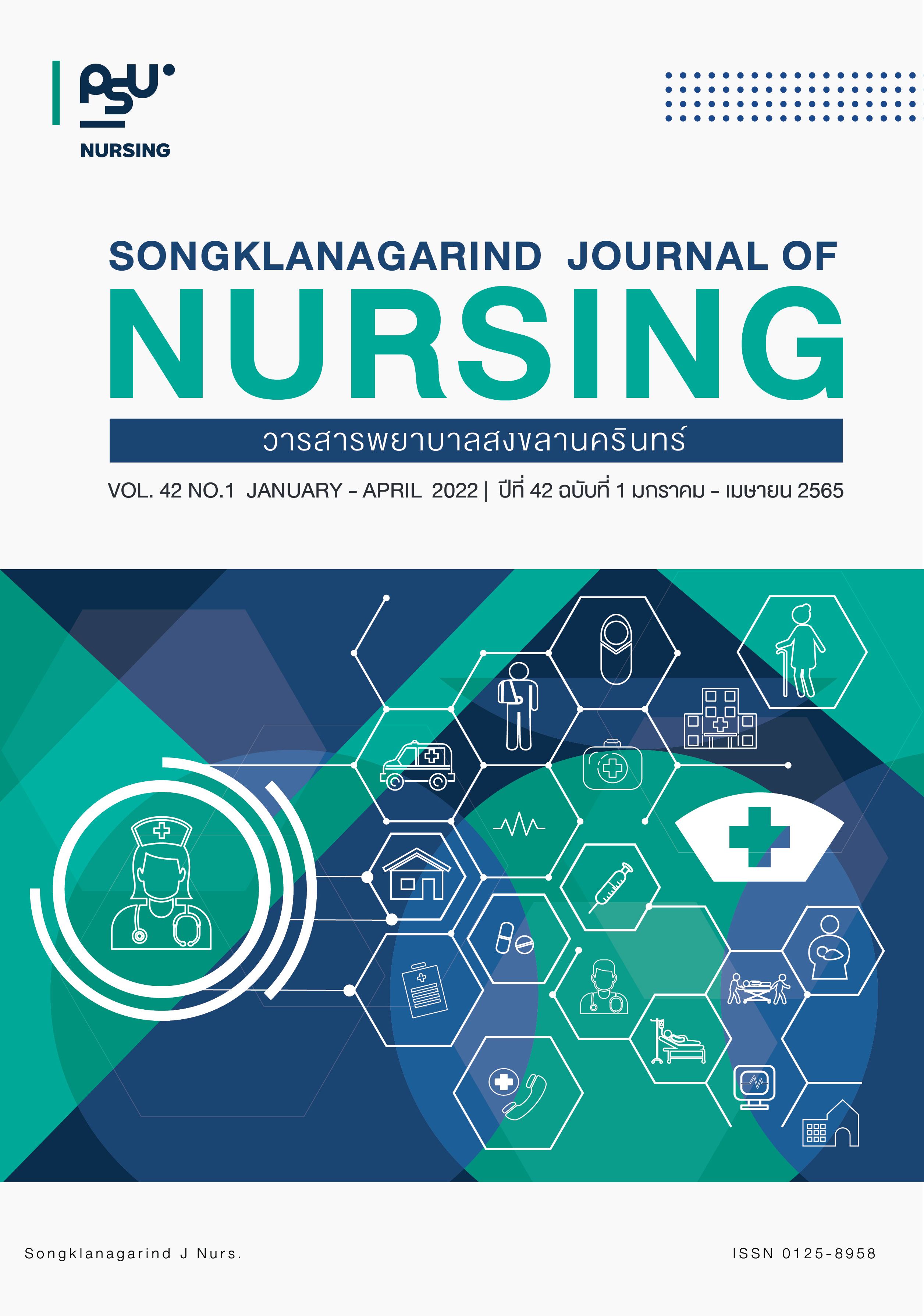Effects of Team-Based Learning on Knowledge and Satisfaction in Pediatric Nursing Course
Main Article Content
Abstract
Objective: This study aims to examine the effects of team-based learning in nursing care for children with respiratory tract problems on knowledge and satisfaction of nursing students. Methods: The participants of quasi-experimental study, one group pre-posttest design, were 197 third-year nursing students who were taught by team-based learning. Three instruments were used to collect data. Individual Readiness-Assurance Test and Individual Post-test, which were examined for content validity, yielding the item objective congruence (IOC) index of .89 and .88, respectively. Satisfaction questionnaire, which was examined for internal consistency reliability, yielding the Cronbach’s alpha coefficient of .93. Data were analyzed using descriptive statistics and Wilcoxon signed - rank test. Results: The findings revealed that the mean rank of knowledge after experiment was significantly higher than those of before the experiment (Z = -8.59, p < .001). The satisfaction level in team-based learning was at a high level, both overall mean scores and item mean scores. Conclusion: Team-based learning should be applied for theory-based courses in order to enhance learning effectiveness.
Article Details

This work is licensed under a Creative Commons Attribution-NonCommercial-NoDerivatives 4.0 International License.
References
Kunaviktikul W. Teaching and learning in the discipline of nursing in the 21st century. Nursing Journal. 2015; 42(2): 152-6. Thai.
Office of the Education Council. National Education Standards 2018. Nonthaburi: 21 Century; 2019. Thai.
Panich W. Learning design for learner in the 21st century. Bangkok: Tathata publication company limited; 2012. Thai.
Srinon R, Srinon U, Yomdit V, et al. Active learning management in the era of Thailand 4.0. J. Educ. Admin. Silpakorn Univ. 2017; 9(2): 323-43. Thai.
Punsawat M, Inchaithep S, Thinwang W, et al. The effectiveness of team-based learning on learning achievement, critical thinking, team work skills and self-directed learning readiness of student nurses. JHNR. 2015; 16(2): 92-102. Thai.
Wutti R, Sittiwong S, Srikrajang J. The effects of team based learning to enhance learning outcomes under thai qualifications framework for higher education and selfdirection in adult learning of students nurses. Journal of Nursing and Health Research. 2016; 17(3): 69-80. Thai.
Yaisoon S, Rattanaviboon P, Chankao C. Effects of teambased learning on knowledge and perceived learning outcomes in antenatal care of nursing students. TRCN J. 2016; 9(2): 73-87. Thai.
Michaelsen LK, Sweet M. The essential elements of teambased learning. New Dir Teach Learn. 2008; 116: 7-27. doi: 10.1002/tl.330.
Thaipisuttikul I. Facilitation in team-based learning. Siriraj Med Bull. 2016; 9(2): 75-83. Thai.
Santanavanich C, Pumpuang W, Thavorn T. The evaluation of team-based learning process in nursing students: Learning outcomes in accordance with Thai qualification framework, feasibility, and readiness assurance of students. J Nurs Sci. 2015; 33(suppl1): 37-47. Thai.
Branson S, Boss L, Fowler DL. Team-based learning: Application in undergraduate baccalaureate nursing education. JNEP. 2016; 6(4): 59-64. doi: 10.5430/jnep.v6n4p59.
Vongchulachat S, Insing S, Thajai S, et al. The effect of team-based learning on student academic achievement and satisfaction learning in child and adolescent nursing I subject at Saintlouis college. JBCN Bangkok. 2017; 33(3): 81-90. Thai.
Sumrithe S. Team-based learning on doctor of medicine program. RMJ. 2018; 41(2): 135-42. Thai.
Cohen J. Statistic power analysis for the behavioral science. 2 nd ed. Newyork: Lawrence Erlbaum Associates; 1988.
Plichta SB, Kelvin EA. MUNRO’S statistical methods for health care research. 6 th ed. China: Lippincott-Raven; 2013.
Turner RC, Carlson L. Indexes of item-objective congruence for multidimensional items. Int J Test. 2003; 3(2): 163-71.
Srisatidnarakul B. The methodology in nursing research. Bangkok: You and I intermedia; 2010. Thai.
Anderson LW, Krathwohl DR. A taxonomy for learning, teaching, and assessing: A revision of Bloom’s taxonomy of educational objectives. New York. David McKay company; 2001.
Nelson M, Tweddell S. Outcomes of implementing teambased learning (TBL): The experiences of UK educators. Res High Educ. 2020; 3(1): 198-212.
Kim HR, Song Y, Lindquist R, et al. Effects of team-based learning on problem-solving, knowledge and clinical performance of Korean nursing students. Nurse Educ Today. 2016; 38: 115-8. doi: 10.1016/j.nedt.2015.12.003.
Jiratchayaporn K, Christraksa W. Using team-based learning for junior nursing students’ preparation before mental health and psychiatric nursing practicum. Int. J. Nurs. Educ. 2020; 12(4): 74-9. doi: 10.37506/ijone.v12i4.11220.
Cheng CY, Liou SR, Hsu TH, et al. Preparing nursing students to be competent for future professional practice: Applying the team-based learning-teaching strategy. J Prof Nurs. 2014; 30(4): 347-56. doi: 10.1016/j.profnurs.2013.11.005.
Lee KE. Effects of team-based learning on the core competencies of nursing students: A quasi-experimental study. JNR. 2018; 26(2): 88-96. doi: 10.1097/jnr.0000000000000259.
Wong AK, Wong FK, Chan LK. The effect of interprofessional team-based learning among nursing students: A quasi-experimental study. Nurse Educ Today. 2018; 53: 13-18. doi: 10.1016/j.nedt.2017.03.004.
Hee CY, Ran KY. Effects of team-based learning on communication competence for undergraduate nursing students. J Korean Acad Psychiatr Ment Health Nurs. 2017; 26(1): 101-10. doi: 10.12934/jkpmhn.2017.26.1.101.
Branney J, Hernández JP. A mixed methods evaluation of team-based learning for applied pathophysiology in undergraduate nursing education. Nurse Educ Today. 2018; 61: 127-33. doi: 10.1016/j.nedt.2017.11.014.


